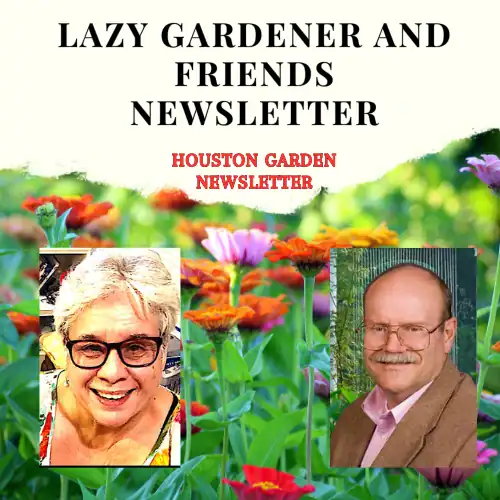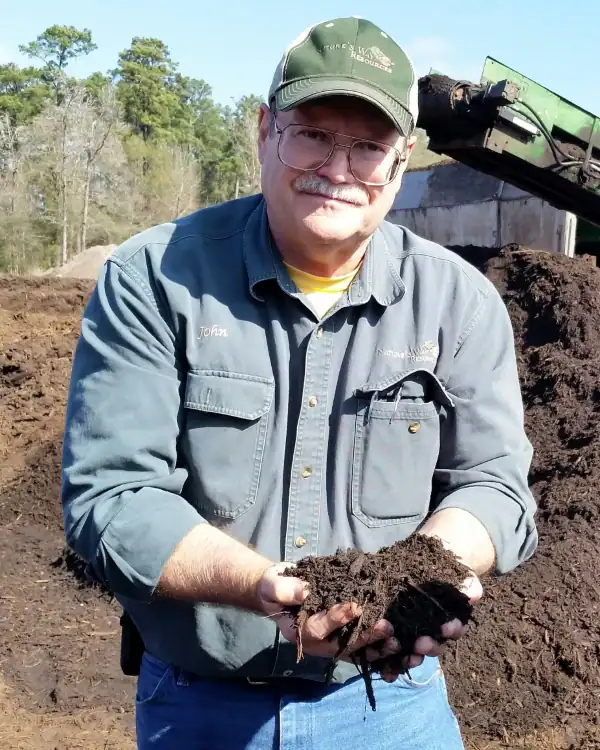
Nature’s Way Resources is proud to produce & email you this free weekly newsletter. We have no ads, but sponsors do graciously help support this project as a public service. Please note their names below & show your gratitude for this free service by patronizing their businesses! To become a sponsor, call (936) 273-1200
Nature’s Way Resources owner John Ferguson, “The Lazy Gardener” Brenda Beust Smith, and Shelby Cassano welcome your feedback and are so grateful to the many horticulturists who contribute their expertise

Time to plant bluebonnets and many other Texas natives! Yes, those “red” ones at the right ARE bluebonnets. Story goes, first Aggie horticulturist to officially find these nearly went berserk with joy. He labeled them “Aggie Maroon” bluebonnets. NAW…. Anyone can see they’re obviously “COUGAR RED” bluebonnets!!!!
KEEP EYE ON OFT-ERRATIC HURRICANES THAT SUDDENLY EXPLODE IN GULF!
BY BRENDA BEUST SMITH (aka The Lazy Gardener)
WOW, it’s September already! Ask any experienced Greater Houston area gardener and they’ll tell you whereas the rest of the country is starting to WIND down on gardening, we along the Gulf of Mexico coast are just at the beginning of our next heaviest — oft most wonderful — gardening period!
Sure, there are cold temperatures ahead. Although we can’t tell, most of our hardier plants have already prepared not only for this but for the equally warm, perfect-healthy-root-growing time ahead. More often than not, failure to accept this reality of how THE GULF COAST AREA IS DIFFERENT will be responsible for many gardening failures next year.
Why isn’t more made of this? It wasn’t as necessary in the past. Folks were more experienced, gardening-oriented, and listened to older gardeners with deep roots here. Now, many, if not most, folks here are from areas with FAR different growing conditions, surrounded by folks like themselves (not experienced), and shopping too often from plant sellers not always tuned in to our sometimes unique environmental challenges.
Rule one: always watch weather reports and shop at our locally-owned garden centers or — even better! — the local organizational sales so popular this time of the year. Ask folks at these sales for fall advice (which differs greatly from other parts of the country).
Now that your mind is on the right path, let’s face a little more gardening reality. We’re already long past July 8, 2024, date Beryl — at last minute! — slammed through Houston. (Don’t forget: it was predicted to BYPASS us). To be on the safe side, now’s the time to . . .
- Time to wander through the yard, check out trees that need trimming, and look for other possible hurricane-triggering-potential damage sources.
- Listen to weathermen, hope for the best, but never doubt major damage may loom. (Beryl was supposed to pass us on its “safer” side — what a joke when you’re talking about hurricanes). Beryl cost us personally a carport, 7 trees, roof repairs, internal house damage, and almost a whole fence around our acre property. If a hurricane is headed even remotely this way, listen to predict pre-landfall talk, assume the worst is possible, and act accordingly.
- Even if we’re headed to a beautiful fall, it’s not too early to take a good yard inventory for damage potential. Some leaves are starting to fall, and more will soon. Bagged leaves in serious garbage bags make great water barriers. We’ve used them successfully. If the storm bypasses, you can always throw them in your garden afterwards.
- Hurricane-potential notwithstanding, warm temperatures along with high humidity — which our plants appreciate more than humans — are September-typical.
- Don’t waste water on air-evaporation (which will happen quickly this month). Get watering devices down as close to the ground and plant bases as possible to cut down on inevitable evaporation.
- Almost all estimates put average loss of water to evaporation from sprinklers in Houston at around 50%. That’s not much actually making it down roots, which are going to start growing upward into hotter areas (worst possible direction) to get more moisture.
Think of now as a “MUSING TIME”. It’s almost impossible to protect all plants from a hurricane or even the outer winds of one. Start with precious/irreplaceables. Good mulching is a must. Leaves perfect. Be aware of plants in direct lines of really-strong winds. A few thoughts usually shared by experts:
- Plan now for potted plants you plan to move inside. Will need good light and soil kept moist. ACs and heaters dry soil very quickly.
- Look upward. Any branches look like they could be blown or knocked into structures by heavy winds? Consider pruning back ones close to house or (especially) windows. Might be worth an arborist’s opinion.
- Don’t assume pots are too heavy to be blown around. Hurricane winds can roll these around! Too heavy to tote inside? Pick spots where you can stick them between thick shrubs or lay them on their sides when time comes.
- Do you know how to disconnect your sprinkler system? Might heavy winds do damage? Plan ahead.
- Make a plan now for where to move water collection barrels to a secure location and, if necessary, disconnect from gutters. Or. move them to where they will help collect water in case yours fails post-storm.
- Pruning pre-hurricane season is a tricky thing. If the tree isn’t dormant, pruning may trigger immediate new growth (more susceptible to damage). Going dormant is a slow natural process.
- Very generally speaking (ideally, you check with an arborist!), deciduous trees (lose leaves naturally in winter) are pruned in winter when they’re dormant. Evergreen trees (keep leaves year-round) are usually pruned in late winter/early spring. Warning: Don’t prune early-blooming trees or shrubs (azaleas, camellias, etc.) until AFTER they bloom in spring. Otherwise, you’ll cut off all developing flowers.
Enough gloom & doom. Hurricanes aside, Fall is a wonderful time here. HERE’S HOPING NONE OF US ACTUALLY NEED ANY OF THE ADVICE THIS FALL OR WINTER!
(More on natives to plant this month, next week in home gardens. Would love to know your favorites! (lazygardenerbrenda@gmail.com)
* * *
Don’t start Fall Plantings Without OUR Urban Harvest Guide!

ON THE GOOD SIDE OF FALL . . . DO YOU HAVE YOUR . . . URBAN HARVEST 2025 FALL PLANTING GUIDE? Free and no one gives you as complete local gardening guide as Urban Harvest!
And ... SPEAKING OF URBAN HARVEST . . .
Normally, I don’t do fundraising pleas here, but given current upheavals seriously affecting social service activities, I am making a big exception. Over the past 5 decades, I’ve seen (and reported on) Urban Harvest‘s growth from non-existence to probably the most incredible resource for home gardeners that we have in the nation, especially for those in need. Now UH desperately needs our help so they can keep helping all of us with their amazingly up-to-date edible, etc., gardening advice and routing donated food to the less fortunate in this city, almost always free for the asking. For more UH’s broad Greater Houston Area advice/activities, click on this link: www.urbanharvest.org/. And give!
* * *

ATTN. GARDEN/PLANT GROUPS
— Nature’s Way Resources offers free guided tours of NWR’s extensive nursery/soil/mulch facilities for garden clubs, plant societies and other plant-oriented, organized groups. As usual, NWR’s now-expanded meeting site is free to above groups. Reservations a must for both. Great time to visit.

Submitting a Calendar Event?
For best chance of getting it in next upcoming newsletter, submit in exact requested format (see top of calendar below. Reformatting by us may = delay in publication)
* * *
John’s Corner
NEWS FROM THE WONDERFUL WORLD OF SOIL AND PLANTS
#344
Subject: Mid-Quality Mulches
|
|
|
Click below to learn more about all of the different types of mulch in detail.
Explore our article library to learn more information about various mulches and other topics.
Sponsorship
If you are interested in becoming a sponsor, please contact us at 936-273-1200 or send an e-mail to: lazygardenerandfriends@gmail.com
About Us
BRENDA BEUST SMITH
WE KNOW HER BEST AS THE LAZY GARDENER . . .
but Brenda Beust Smith is also:
- a national award-winning writer & editor
- a nationally-published writer & photographer
- a national horticultural speaker
- a former Houston Chronicle reporter
When the Chronicle discontinued Brenda’s 45-year-old Lazy Gardener” print column — started in the early ’70s as a fun side-project to reporting, it then ranked as the longestrunning, continuously-published local newspaper column in the Greater Houston area. The name, she says, is not just fun, it’s true.
Brenda’s gradual sideways step from reporter into gardening writing led first to an 18-year series of when-to-do-what Lazy Gardener Calendars, then to her Lazy Gardener’s Guide book which morphed into her Lazy Gardener’s Guide on CD, which she now emails free upon request.
Brenda became a Harris County Master Gardener and, over the years, served on theboards of many Greater Houston area horticulture organizations. She hosted local radio and TV shows, most notably a 10+-year Lazy Gardener specialty shows on HoustonPBS (Ch. 8) and her call-in “EcoGardening” show on KPFT-FM.
For over three decades, Brenda served as Assistant Production Manager of the GARDEN CLUB OF AMERICA’S “BULLETIN” magazine. Although still an active broad-based freelance writer, Brenda’s main focus now is THE LAZY GARDENER & FRIENDS HOUSTON GARDEN NEWSLETTER with John Ferguson and Pablo Hernandez of Nature’s Way Resources.
A native of New Orleans and graduate of St. Agnes Academy and the University of Houston, Brenda lives in Humble, TX, and is married to the retired Aldine High School Coach Bill Smith. They have one son, Blake.
Regarding this newsletter, Brenda is the lead writer, originator of it and the daily inspiration for it. We so appreciate the way she has made gardening such a fun way to celebrate life together for such a long time.
About her column, Brenda says: “I don’t consider myself a ‘garden writer.” I started out 50+ years ago as a very lazy “gardening reporter.” I still feel that way today. I hope my columns inspire/help newcomers, but I do not write to them. I write to very experienced gardeners who want to expand their horizons.
JOHN FERGUSON
John is a native Houstonian and has over 35 years of business experience. He owns Nature’s Way Resources, a composting company that specializes in high quality compost, mulch, and soil mixes. He holds a MS degree in Physics and Geology and is a licensed Soil Scientist in Texas.
John has won many awards in horticulture and environmental issues. For years he represented the composting industry on the Houston-Galveston Area Council for solid waste. His personal garden has been featured in several horticultural books and “Better Homes and Gardens” magazine. His business has been recognized in the Wall Street Journal for the quality and value of their products. He is a member of the Physics Honor Society and many other professional societies. John is the co-author of the book Organic Management for the Professional.
For this newsletter, John contributes articles regularly and is responsible for publishing it.
PABLO HERNANDEZ Pablo Hernandez is the special projects coordinator for Nature’s Way Resources. His realm of responsibilities include: serving as a webmaster, IT support, technical problem solving/troubleshooting, metrics management and quality control. Pablo helps this newsletter happen from a technical support standpoint.
Download the Newsletter with Our Events Calendar Below!

NATURE’S WAY RESOURCES
101 Sherbrook Cir.
Conroe, TX 77385
Hours of Operation
Monday – Friday: 8AM to 5PM
Saturday: 8AM to 2PM
Copyright © 2024 Nature’s Way Resources | All rights reserved.



